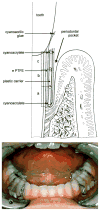Composition and development of oral bacterial communities
- PMID: 24320954
- PMCID: PMC3876289
- DOI: 10.1111/j.1600-0757.2012.00453.x
Composition and development of oral bacterial communities
Abstract
The oral bacterial microbiome encompasses approximately 700 commonly occurring phylotypes, approximately half of which can be present at any time in any individual. These bacteria are largely indigenous to the oral cavity; this limited habitat range suggests that interactions between the various phylotypes, and between the phylotypes and their environment, are crucial for their existence. Molecular cataloging has confirmed many basic observations on the composition of the oral microbiome that were formulated well before ribosomal RNA-based systematics, but the power and the scope of molecular taxonomy have resulted in the discovery of new phylotypes and, more importantly, have made possible a level of bacterial community analysis that was unachievable with classical methods. Bacterial community structure varies with location within the mouth, and changes in community structure are related to disease initiation and disease progression. Factors that influence the formation and the evolution of communities include selective adherence to epithelial or tooth surfaces, specific cell-to-cell binding as a driver of early community composition, and interorganismal interaction leading to alteration of the local environment, which represents the first step on the road to oral disease. A comprehensive understanding of how these factors interact to drive changes in the composition of the oral microbial community can lead to new strategies for the inhibition of periodontal diseases and dental caries.
Published 2013. This article is a US Government work and is in the public domain in the USA.
Figures


References
-
- Beighton D, Smith K, Hayday H. The growth of bacteria and the production of exoglycosidic enzymes in the dental plaque of macaque monkeys. Arch Oral Biol. 1986;31:829–835. - PubMed
Publication types
MeSH terms
Grants and funding
LinkOut - more resources
Full Text Sources
Other Literature Sources
Molecular Biology Databases

